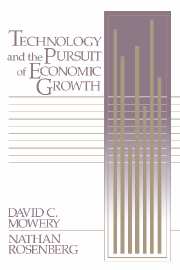Book contents
- Frontmatter
- Contents
- Preface
- Part I Introduction
- Part II The development of the institutional structure, 1860–1940
- Part III The development of the postwar system, 1940–1987
- Part IV New environment, new research organizations
- 8 The changing context of innovation, 1980–present
- 9 International and domestic collaboration in research and development
- 10 The merger of technology and trade policies
- 11 Concluding observations
- Bibliography
- Index
8 - The changing context of innovation, 1980–present
Published online by Cambridge University Press: 22 March 2010
- Frontmatter
- Contents
- Preface
- Part I Introduction
- Part II The development of the institutional structure, 1860–1940
- Part III The development of the postwar system, 1940–1987
- Part IV New environment, new research organizations
- 8 The changing context of innovation, 1980–present
- 9 International and domestic collaboration in research and development
- 10 The merger of technology and trade policies
- 11 Concluding observations
- Bibliography
- Index
Summary
The R&D system that emerged from wartime underwent little change during 1945–80. Federal funds provided most of the financial support for R&D, and industry dominated its performance. The role of industry as a performer of basic research relative to that of universities declined during this period, and the relative importance of military and space-related research experienced some sizable swings; but otherwise the overall structure of the U.S. R&D system was remarkably stable. Beginning in the 1970s and emerging with particular force in the 1980s, however, several developments have created increasing pressure for structural change within the U.S. R&D system. Changes in the international economic environment within which U.S. firms operate and in the financial and organizational requirements of innovation have been largely responsible for the quickening pace of change in the U.S. R&D system.
In this chapter we discuss the forces of change and examine the new environment for commercial innovation that they have produced. In Chapter 9 we consider several of the resulting shifts in the structure of the research system, including the growth in multinational collaborative ventures and the rise of domestic research collaboration within the U.S. economy. Because of its recent successes in commercializing new technologies, the frequent reference to it as a model for U.S. managers and public policymakers, and what we perceive as the increasing pressures for change within it, we also discuss Japan's R&D system in this chapter.
- Type
- Chapter
- Information
- Technology and the Pursuit of Economic Growth , pp. 205 - 237Publisher: Cambridge University PressPrint publication year: 1989



